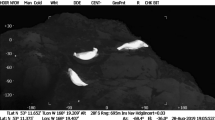Abstract
A commercially available thermal-infrared scanning system was used to survey populations of several wildlife species. The system's ability to detect species of different sizes in varying habitats relative to conventional survey methods, to differentiate between species in the same habitat, and the influence of environtmental factors on operational aspects of employing this technology in the field were evaluated. Total costs for the surveys were approximately $0.36/ha. There were marked discrepancies in the counts of untrained observers and those from trained analysis. Computer-assisted analysis of infrared imagery recorded 52% fewer deer than were estimated from drive counts, and densities of moose were five times those estimated from conventional aerial methods. By flying concentric circles and using telephoto, detailed counts of turkeys and deer were possible. With the aid of computer-assisted analysis, infrared thermography may become a useful wildlife population survey tool. More research is needed to verify the actual efficiency of detection by combining aerial scans with ground truthing for a variely of species and habitals.
Similar content being viewed by others
Literature Cited
Addison, R. B. 1972. The possible use of thermal infrared imagery for wildlife census.Proceedings of the 8th North American moose conference and workshop 8:301–325
Boer, A. H., G. Redmond, and T. J. Pettigrew. 1989. Loran-C: A navigation aid for aerial surveys.Journal of Wild-life Management 53:228–230.
Caughley, G., and J. Goddard. 1972. Improving the estimates for inaccurate censuses.Journal of Wildlife Management 36:135–140.
Croon, G. W., D. R. McCullough, C. E. Olson, Jr., and L. M. Queal. 1968. Intreated scanning techniques for big game censusing.Journal of Wildlife Management 32:751–759
Davis, D. E., and R. L. Winstead. 1980. Estimating the numbers of wildlife populations. Pages 221–245in S. D. Schemnitz (ed.), Wildlife techniques manual, 4th ed. The Wildlife Society, 686 pp.
Graves, H. B., E. D. Bellis, and W. M. Knuth. (1972). Censusing white-tailed deer by airborne thermal infrared imagery.Journal of Wildlife Management 36:875–884.
Isakson, R. E., H.D. Werner, and F. A. Schmer. 1985. White-tailed deer census in selected areas of eastern South Dakota using remote sensing tecnniques. South Dakota State University, Remote Sensing Instructional Report RSI-SDSU-75-04, 31 pp.
LeResche, R. E., and R. A. Rausch. 1974. Accuracy and precision of aerial moose censusing.Journal of Wildlife Management 40:429–441.
McCullough D. R., C. E. Olson, Jr., and L. M. Queal. 1969. Progress in large animal census by thermal mapping. Pages 138–147in P. L. Johnson (ed.), Remote sensing in ecology. University of Georgia Press, Athens.
Parker, H. D., Jr. 1972. Airborne infrared detection of deer. PhD thesis. Clorado State University, Fort Collins, 186 pp.
Patric, E. F., T. P. Husband, C. G. Mickiel, and W. M. Sullivan. 1988. Potential of Loran-C for wildlife research along coastal landscapes.Journal of Wildlife Management 52:162–164.
Trivedi, M. M., C. L. Wyatt, and D. R. Anderson. 1982. A multispectral approach to remote detection of deer.Photogrammetric Engineering and Remote Sensing 48:1879–1889.
Trivedi, M. M., C. L. Wyatt, D. R. Anderson, and H. T. Voorheis. 1984. Designing a deer detection system using a multistage classification approach.Photogrammetric Engineering and Remote Sensing 50:481–491.
Wiggers, E. P., and S. F. Beckerman. 1993. Use of thermal infrared sensing to survey white-tailed deer populations.Wildlife Society Bulletin 21:263–268.
Wyatt, C. L., M. M. Trivedi, and D. R. Anderson. 1980. Statistical evaluation of remotely sensed thermal data for deer census.Journal of Wildlife Management 44:397–402.
Wyatt, C. L., M. M. Trivedi, D. R. Anderson, and M. C. Pate. 1985. Measurement techniques for spectral characterization for remote sensing.Photogrammetric Engineering and Remote Sensing 51:245–251.
Author information
Authors and Affiliations
Rights and permissions
About this article
Cite this article
Garner, D.L., Underwood, H.B. & Porter, W.F. Use of modern infrared thermography for wildlife population surveys. Environmental Management 19, 233–238 (1995). https://doi.org/10.1007/BF02471993
Issue Date:
DOI: https://doi.org/10.1007/BF02471993




